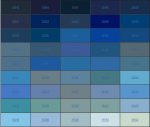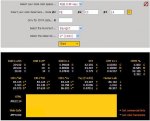I wish there was a correlation between the FS595 color codes and the real world, but there is not. It would make it a lot easier and cheaper to match paint, especially for those overseas owners of US MVs. Our overseas enthusiasts have a similar problem with their 'standards', RAL and BS381c.
What's wrong with the FS595B code? To start, it's arbitrary, as in the numbers have little to no relation to real colors, though they are roughly grouped by hue. It's non-sequential, meaning that the shade, intensity, or saturation of two adjacent colors in the code do not necessarily increase or decrease with the numeric values.
A brief description of the FS595 code:
An FS595 color palette sample (blue):

How can we fix this? Convert the code into some standard format, like RGB, CMYK, or one of the fancier systems, like Munsell or CIELAB. RGB and CMYK have their limitations, so the CIELAB format is probably the best, and I believe it is the default output of the spectrophotometers used in many auto and home paint shops. If I can not find this conversion already done (oh, I sure hope I can), I will probably order an FS595 chip set and do this myself. Actually, they're too darn expensive, so I'll have to start with just the colors I'm intersted in. But rather than spend a few days in a Maaco, Sherwin-Williams, or Home Depot using their spectrophotometer, I might buy a relatively cheap unit like this Pantone - Color Cue®2.1. Afterwards, it will be another cool tool/toy for my workbench.![Thumbs Up [thumbzup] [thumbzup]](https://www.steelsoldiers.com/images/smilies/icon_smile_thumzup.gif)
So far, the best conversion resource I have found is this chart (it can be downloaded as a zipped PDF), which I believe was created primarily for modellers. It's pretty cool, but has lots of missing info that could easily be filled in with info gathered from color samples and a spectrophotometer. Here is a sample output for FS 33538 Insignia Yellow, with BS381c, RAL, and RGB codes selected for display:

Though I don't know how accurate they are, since FS 33538 crosses to BS381c 356 AND 368, the RGB values in the above chart can be used to calculate the rough equivalent values in just about any other system, as seen from a screen capture of this online calculator:

Am I wasting my time? Do you think it is a good, worthwhile idea? Has someone else or the govt already done this and I haven't found it? It just seems to make sense to make this conversion. With modern instruments and paint technology that was lacking when FS595 was developed, it should be a done deal.
Has someone else or the govt already done this and I haven't found it? It just seems to make sense to make this conversion. With modern instruments and paint technology that was lacking when FS595 was developed, it should be a done deal.
What's wrong with the FS595B code? To start, it's arbitrary, as in the numbers have little to no relation to real colors, though they are roughly grouped by hue. It's non-sequential, meaning that the shade, intensity, or saturation of two adjacent colors in the code do not necessarily increase or decrease with the numeric values.
A brief description of the FS595 code:
- Composed of 5 digits.
- The first digit represents the glossiness on a scale of 1-3, with 1 being glossy and 3 being flat/lusterless.
- The second digit represents the color, usually/sort of. 0=Brown, 1=Red, 2=Orange, 3=Yellow, 4=Green, 5=Blue, 6=Grey, 7=Other, and 8=Flourescent.
- The last 3 digits are suppose to represent the intensity, with a lower number being a darker color, but I haven't found this to be accurate, to my perception anyway.
An FS595 color palette sample (blue):

How can we fix this? Convert the code into some standard format, like RGB, CMYK, or one of the fancier systems, like Munsell or CIELAB. RGB and CMYK have their limitations, so the CIELAB format is probably the best, and I believe it is the default output of the spectrophotometers used in many auto and home paint shops. If I can not find this conversion already done (oh, I sure hope I can), I will probably order an FS595 chip set and do this myself. Actually, they're too darn expensive, so I'll have to start with just the colors I'm intersted in. But rather than spend a few days in a Maaco, Sherwin-Williams, or Home Depot using their spectrophotometer, I might buy a relatively cheap unit like this Pantone - Color Cue®2.1. Afterwards, it will be another cool tool/toy for my workbench.
So far, the best conversion resource I have found is this chart (it can be downloaded as a zipped PDF), which I believe was created primarily for modellers. It's pretty cool, but has lots of missing info that could easily be filled in with info gathered from color samples and a spectrophotometer. Here is a sample output for FS 33538 Insignia Yellow, with BS381c, RAL, and RGB codes selected for display:

Though I don't know how accurate they are, since FS 33538 crosses to BS381c 356 AND 368, the RGB values in the above chart can be used to calculate the rough equivalent values in just about any other system, as seen from a screen capture of this online calculator:

Am I wasting my time? Do you think it is a good, worthwhile idea?
 Has someone else or the govt already done this and I haven't found it? It just seems to make sense to make this conversion. With modern instruments and paint technology that was lacking when FS595 was developed, it should be a done deal.
Has someone else or the govt already done this and I haven't found it? It just seems to make sense to make this conversion. With modern instruments and paint technology that was lacking when FS595 was developed, it should be a done deal.
Last edited:


